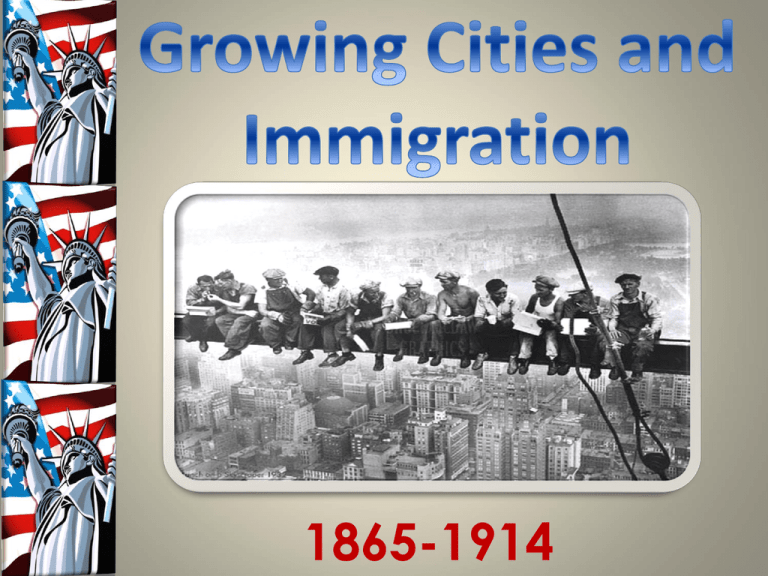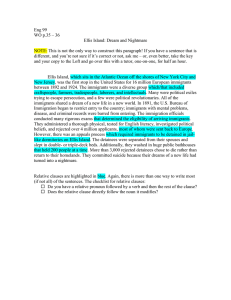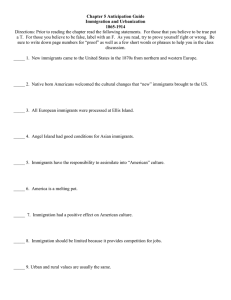1865-1914
advertisement

1865-1914 • The growth of cities Why did cities grow and develop? • Movement of Americans from rural (farm) to urban (city) areas for job opportunities • Industries often located near population centers • Inventions helped cities and industry grow • Immigration from other countries Immigration: the moving from one country to another country to live. • Hope for better opportunities •Escape from oppressive governments •Adventure • Religious freedom HEAR • Between 1865-1915 more than 13.5 million immigrants came to the USA • Prior to 1871, most immigrants to America came from northern and western Europe: Germany, Great Britain, Norway, and Sweden • During between1871-1921, most immigrants came from Southern and Eastern Europe: Italy, Greece, Poland, Russia, etc. • As well as China and Japan How did immigrants get here? • Passage to the United States often cost a life’s savings. Entire families would often save money to send just one or two family members to America, hoping that eventually these members could afford to bring over the rest of the family Travel Dangers: • Disease and death • Sickening Smells • Overcrowded “During the twelve days in the steerage I lived in … surroundings that offended every sense. Only a fresh breeze from the sea overcame the sickening odors. Everything was dirty, sticky, and disagreeable to the touch.” • Immigrants from Europe entered America through Ellis Island in New York Harbor. Their first view of America was often The Statue of Liberty. • In 1890, Congress designated three acre Ellis Island in Upper New York Bay as an immigration station. • By 1910, six million immigrants had come through Ellis Island • Located at New York Harbor • Greeted Immigrants as they entered Ellis Island “Give me your tired, your poor, your huddled masses yearning to breath free, The wretched refuse of your teeming shore. Send these, the homeless, tempesttossed to me, I lift my lamp beside the golden door!” - Emma Lazarus Inspections: • Medical inspections were performed • Asked 32 background questions • Immigrants with contagious diseases were shipped back • The immigrant inspection process was a humiliating and dehumanizing experience • Many immigrants had their name changed by the inspectors because they didn’t have time or patience to struggle with the foreign spellings • Long lines – immigrants were tagged by the language they spoke and marked according to their medical ailments • Located in San Francisco Bay, California • Between 1910 – 1940 Angel Island processed 1 million Asian immigrants entering the U.S. • Considered more harsh than Ellis Island. Immigrants made valuable contributions to the growth of business in America: • Chinese workers helped to build the Transcontinental Railroad. Immigrants made valuable contributions to the growth of business in America: • Northeast immigrants worked in textile and steel mills Immigrants made valuable contributions to the growth of business in America: • Slavs, Italians, and Poles worked in the coal mines of the East • They often worked for very low pay and in dangerous working conditions to help build the nation’s industrial strength. • Women and children were desirable for small hands and could pay them less • 1 in 5 children between 10 and 16 were employed • Overcrowded immigrant neighborhoods • Settled in the big cities where factory jobs were available. (By 1900, 4 out of every 5 people in NYC were immigrants.) • Tenements – a crowded, urban, run-down building with small, cheap apartments • Lived in crowded, dirty tenement buildings • Families shared space • Light and fresh air were scarce • Melting Pot: used to describe the US as a place where cultures blend, creates a unique American culture. • Assimilation: Adopting another country’s culture as your own. “Great American Melting Pot” • • Despite their hard work, immigrants faced hardship, hostility, and discrimination. Nativism - fear that immigrants would take jobs from American workers, and belief that native Americans were superior Discrimination against immigrants: • Irish • Chinese • As cities grew, so did political machines • Political machines are organizations that controlled the activities of a political party through corruption and bribery. • “Political Bosses” worked to ensure their candidates were elected • The “Boss” controlled jobs, business licenses, and influenced the court system • Political Machines often helped immigrants with citizenship, jobs, and housing in exchange for votes. Boss Tweed ran NYC




